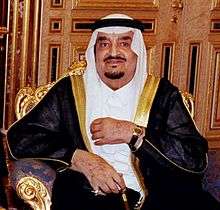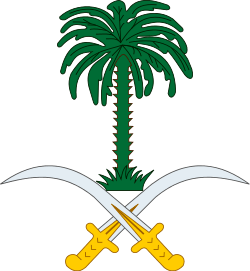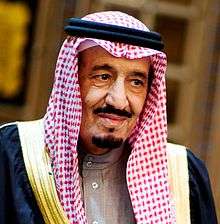Sudairi Seven

The Sudairi Seven (Arabic: السديريون السبعة, as-Sudayriyyūn as-Sabʿah), also spelled Sudairy or Sudayri, is the commonly used name for a powerful alliance of seven full brothers within the House of Saud. They are also sometimes referred to as the Sudairi Clan (Arabic: عائلة السديري ʿĀʾilat as-Sudayrī) or the Sudairi faction. The oldest (Fahd) served as king from 1982 to 2005; the second- and fourth-oldest (Sultan and Nayef) served as crown prince but predeceased King Abdullah, and the sixth-oldest (Salman) succeeded Abdullah as king in 2015. There are currently three surviving members, including the present king.
Origins and composition
In the early twentieth century, King Abdulaziz rapidly expanded his power base in Nejd to establish the Kingdom of Saudi Arabia in 1932, and became its first King. As part of this process of expansion, he married women from powerful Nejdi and other Arabian families to cement his control over all parts of his new domain. It is believed he married as many as 22 women as a result.[1] One of these marriages was to Hussa bint Ahmed Al Sudairi, a member of the Al Sudairis, a powerful clan in Nejd, where the Wahhabi ideology emerged nearly 300 years ago.[2]
The Seven
 Fahd (1921–2005)
Fahd (1921–2005)
fifth King of Saudi Arabia
(13 June 1982 – 1 August 2005)
Crown Prince (1975–82)
2nd Deputy Prime Minister (1967–75)
Minister of the Interior (1963–75)

 Nayef (1934–2012)
Nayef (1934–2012)
Interior Minister (1975-2012)
First Deputy Prime Minister and Crown Prince
(27 October 2011 – 16 June 2012) Turki (1934-2016), Deputy Defense Minister (1968–78) removed from succession
Turki (1934-2016), Deputy Defense Minister (1968–78) removed from succession Salman (born 1935)
Salman (born 1935)
seventh King of Saudi Arabia (2015-)
Governor of Riyadh
(1963-5 November 2011)
Minister of Defense
(5 November 2011 – 22 January 2015)
Crown Prince
(18 June 2012 – 22 January 2015)
Their sisters
- Princess Luluwah (1928–2008) is married to her second cousin once removed Faisal bin Turki bin Abdullah bin Saud Al Saud
- Princess Latifa
- Princess Al Jawhara is married to her half first cousin Prince Khalid bin Abdullah bin Abdul Rahman Al Saud (born 1937)
- Princess Jawaher
The Royal succession
The number of children that King Abdulaziz fathered in total, with all his wives, is unknown. One source indicates that he had 37 sons.[1] The "Sudairi Seven" – the seven sons of King Abdulaziz and Hassa bint Ahmed – were the largest bloc of full brothers and as a consequence, were able to wield a degree of coordinated influence and power.[4]
Robert Lacey in his book The Kingdom lists 43 sons of King Abdulaziz and states that Princess Hassa was actually married to him twice, and the first marriage had produced another son, Prince Sa'ad (1914–19), whom others attribute to Princess Tarfah.
Rise to power

The influence of the Sudairi Seven, which can be termed as asabiyya (group spirit) following the khaldûnian terminology, grew constantly after the accession of its leader, Prince Fahd, to crown prince in 1975 and then king in 1982.[5] They represented one out of five of King Abdulaziz’s sons. However, they gained influence and power not solely because of their number.[6] Unlike many of King Abdulaziz's other sons who dealt much more with business activities, the Sudairi Seven tended to be interested in politics.[6]
The Sudairi Seven's rise to power can be traced back to the accession of King Faisal and his earlier struggle with King Saud. Although not a Sudairi himself, Prince Faisal, in his struggle to overthrow Saud, relied heavily upon the seven Sudairi brothers. In 1962, as prime minister and heir apparent, Prince Faisal appointed Prince Fahd as Interior Minister, Prince Sultan as Defense Minister, and Prince Salman as governor of Riyadh. All were key posts. Following Prince Faisal's accession to the throne after King Saud's deposition in 1964, the King Faisal continued to favor the Sudairi Seven as his allies.[4]
In 1975, following the death of King Faisal and the accession of King Khalid, Prince Fahd became Crown Prince and Prince Nayef succeeded him at the Ministry of Interior.[4]
The Sudairis consolidated their hold over these fiefs by appointing their brothers and sons to their own ministries and other key positions: Late Prince Sultan appointed one of his younger Sudairi brothers — Prince Abdul Rahman — and one of his sons as his deputies, Prince Khalid. Another of Prince Sultan’s sons, Prince Bandar, served for two decades as Saudi ambassador in Washington and then head of the Saudi National Security Council.[4] His other son Prince Khalid, the co-commander with U.S. General Norman Schwarzkopf in the Gulf War (1991), became vice defence minister.[7] Late Nayef also appointed one of his sons — Muhammad — as his deputy at the Ministry of the Interior.[4]
The Sudairis’ rise to power and hold over government brought continuity to the system. It also prompted other princes to align quietly against them. The main opposition to the Sudairis came from Prince Abdullah prior to his accession to the throne. He cultivated allies among his other brothers and with King Faisal’s sons. Upon Prince Abdullah's accession to the throne, he created a new family council, the Allegiance Commission, to determine the future succession. The Sudairis filled a fifth of the council’s seats which is seen as a dilution of Sudairi power since their overall control over the state is perceived as proportionately greater than this.[4]
The clan in the reign of King Abdullah (2005-15)
Mai Yamani argues that Sudairi brothers previously known as the ‘Sudairi seven’ since King Fahd’s death in August 2005 reduced to al-Thaluth (‘the trio’), referring only to Prince Sultan, Prince Nayef and Prince Salman.[8] And Prince Sultan became the leader of the group after King Fahd's demise.[9]
On 28 October 2011, Prince Nayef became the Crown Prince after the death of his full brother Prince Sultan, and his other full brother Prince Salman who had been long-term Riyadh governor, was appointed the minister of defence. However, the eldest surviving member of the Sudairi brothers, Prince Abdul Rahman, was replaced by late Prince Sultan's son Prince Khalid as deputy minister of defence.[10]
In other words, Prince Abdul Rahman was deputy minister of defence and general inspection until November 2011, but was relieved when his younger brother Prince Salman was appointed as the Minister. Prince Abdul Rahman was reported to argue that he should have been promoted instead of Prince Salman. On the other hand, the youngest of the Sudairi brothers Ahmed, who was late Prince Nayef's deputy at the ministry of interior since 1975, was reported to complain about that Prince Nayef was actively promoting the interest of his own son, Prince Mohammed. Lastly, another Sudairi Prince Turki, who returned to Riyadh in early 2011 after a long and at least partly voluntary exile in Cairo, was said to agitate for a more senior position.[11] On the other hand, Prince Turki fully supported the appointment of late Prince Nayef as Crown Prince, indicating that the decision was totally right and that Prince Nayef had wisdom, sound management and long history in serving the country.[12] However, although Sudairi brothers support each other against other princes, each attempts to form, with his sons, another power group.[13]
On 16 June 2012, Crown Prince Nayef died in Geneva. His posts, namely Crown Prince, deputy prime minister and interior minister, were filled by his younger full-brothers. Specifically, Prince Salman was named as the Crown Prince and deputy prime minister, and Prince Ahmed as the minister of interior on 18 June 2012.[14] In short, Prince Salman and Prince Ahmed were the only politically active members of the group.[15] However, on 5 November 2012, Prince Ahmed resigned from his post and was succeeded by Mohammed bin Nayef, son of late Prince Nayef.[3] On 23 January 2015, King Abdullah died and was succeeded by Salman.
Current Status
With the death of the old King, the new King immediately began to consolidate power on behalf of the clan. His son became both minister of defense and secretary general of the Court, combining two of the most powerful offices in the government, and his full nephew Mohammed bin Nayef bypassed hundreds of senior princes to become the first of the third generation to be officially placed in the line of succession. On 28 April 2015 Mohammed bin Nayef was named Crown Prince replacing Sudairi Sevens half brother Prince Muqrin bin Abdulaziz.[16]
References
- 1 2 Simon Henderson. "New Saudi Rules on Succession: Will They Fix the Problem?" (PolicyWatch #1156), Washington Institute for Near East Policy, 25 October 2006
- ↑ Irfan Al Alawi (24 October 2011). "Saudi Arabia – The Shadow of Prince Nayef". Center for Islamic Pluralism. Retrieved 24 April 2012.
- 1 2 "Saudi Arabia's king appoints new interior minister". BBC. 5 November 2012. Retrieved 5 November 2012.
- 1 2 3 4 5 6 "The Saudi succession: When kings and princes grow old", The Economist, 15 July 2010.
- ↑ Mordechai Abir (1987). "The Consolidation of the Ruling Class and the New Elites in Saudi Arabia". Middle Eastern Studies. 23 (2): 150–171. doi:10.1080/00263208708700697. JSTOR . 4283169 .
- 1 2 Taheri, Amir (2012). "Saudi Arabia: Change Begins within the Family". The Journal of the National Committee on American Foreign Policy. 34 (3): 138 143. doi:10.1080/10803920.2012.686725.
- ↑ MacFarquhar, Neil, "Prince Sultan bin Abdel Aziz of Saudi Arabia Dies", The New York Times, 23 October 2011. Retrieved 23 October 2011
- ↑ Mai Yamani (2008). "The two faces of Saudi Arabia". Survival. 50 (1): 143–156. doi:10.1080/00396330801899488.
- ↑ William Safire (12 September 2002). "The Split in the Saudi Royal Family". The New York Times. Retrieved 13 April 2013.
- ↑ Nathanie Kernl; Matthew M. Reed (15 November 2011). "Change and succession in Saudi Arabia". Foreign Reports Bulletin. Retrieved 25 May 2012.
- ↑ Ian Bremmer (2 March 2012). "The next generation of Saudi royals is being groomed". Foreign Policy. Retrieved 26 May 2012.
- ↑ "Saudis swear allegiance to Crown Prince". Zawya. 30 October 2011. Retrieved 19 August 2012.
- ↑ Joshua Teitelbaum (8 December 2010). "King Abdullah's Illness and the Saudi Succession". Jerusalem Center for Public Affairs. Retrieved 26 April 2012.
- ↑ Neil MacFarquhar (18 June 2012). "Defense Minister New Heir to Throne in Saudi Arabia". The New York Times. Retrieved 19 June 2012.
- ↑ Abdullah Al Shihri; Brian Murphy (18 June 2012). "Salman bin Abdulaziz, Saudi Arabia's Defense Minister, Named Crown Prince". Huffington Post. AP. Retrieved 20 June 2012.
- ↑ Saudi king appoints nephew as crown prince Al Jazeera. 29 April 2015. Retrieved 30 April 2015.